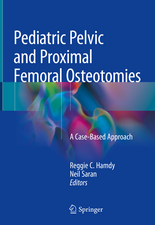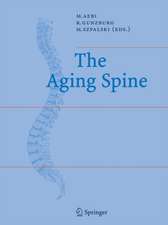Surgery for Low Back Pain
Editat de Marek Szpalski, Robert Gunzburg, Björn L. Rydevik, Jean-Charles Le Huec, H. Michael Mayeren Limba Engleză Hardback – 20 apr 2010
| Toate formatele și edițiile | Preț | Express |
|---|---|---|
| Paperback (1) | 907.49 lei 38-44 zile | |
| Springer Berlin, Heidelberg – 13 dec 2014 | 907.49 lei 38-44 zile | |
| Hardback (1) | 1050.91 lei 3-5 săpt. | |
| Springer Berlin, Heidelberg – 20 apr 2010 | 1050.91 lei 3-5 săpt. |
Preț: 1050.91 lei
Preț vechi: 1106.23 lei
-5% Nou
Puncte Express: 1576
Preț estimativ în valută:
201.12€ • 207.49$ • 170.22£
201.12€ • 207.49$ • 170.22£
Carte disponibilă
Livrare economică 12-26 februarie
Preluare comenzi: 021 569.72.76
Specificații
ISBN-13: 9783642045462
ISBN-10: 3642045464
Pagini: 285
Ilustrații: XIV, 285 p.
Dimensiuni: 193 x 260 x 27 mm
Greutate: 0.91 kg
Ediția:2010
Editura: Springer Berlin, Heidelberg
Colecția Springer
Locul publicării:Berlin, Heidelberg, Germany
ISBN-10: 3642045464
Pagini: 285
Ilustrații: XIV, 285 p.
Dimensiuni: 193 x 260 x 27 mm
Greutate: 0.91 kg
Ediția:2010
Editura: Springer Berlin, Heidelberg
Colecția Springer
Locul publicării:Berlin, Heidelberg, Germany
Public țintă
Professional/practitionerCuprins
Basics.- The Biology of Intervertebral Disc Degeneration.- Low Back Pain: Where Does the Pain Come From?.- The Role of Cytokines in the Degenerative Spine.- Psychosocial Aspects of Low Back Pain.- Instability and Low Back Pain.- Diagnosis.- Dynamic MRI of the Spine.- Assessment of Status of End Plate and Diffusion in Degenerative Disc Disease.- The Role of Physician Extenders in a Low Back Pain Practice.- Conservative Treatment.- Natural Evolution of Nonspecific Low-Back Pain.- Prescribing Conservative Treatment for Low Back Pain.- Comprehensive Rehabilitation for Low back Pain and Back Schools.- The Place of Chiropractic Care in the Treatment of Low Back Pain.- Efficacy of IDET and PIRFT for the Treatment of Discogenic Low Back Pain.- Lumbar Orthoses to Prevent and Treat Low-Back Pain.- Surgical Treatment: Fusion.- Indication for Lumbar Spinal Fusion.- Evidence for Efficacy of Pedicle-Based Systems.- Low Back Pain Is Not an Indication for Stabilisation in Patients Operated for Lumbar Spinal Stenosis.- Hybrid Construct for DDD in the Lumbar Spine: The Compromise Between Fusion and Nonfusion.- The Management of Spondylolysis and Spondylolisthesis.- Transpedicular-Transdiscal-Transcorporal (TPDC)-Fixation.- Facet Problems: A Surgical Indication?.- “Myth” or “Fact”.- Pelvic Girdle Pain: Indication for Surgery?.- Blood Loss Management in Major Spine Surgery.- Surgical Treatment: Other Technologies.- How Disc Replacement Fits in the Treatment Algorithm for Degenerative Disc Disease: Refining Indications for Disc Replacement.- Clinical Factors that May Affect Outcome in Lumbar Total Disc Replacement. What Is the Evidence?.- A Prospective Randomized Comparison of Two Lumbar Total Disk Replacements.- Limitations of Lumbar Disk Arthroplasty.- Is Posterior DynamicStabilization an Option to Avoid Adjacent Segment Decompensation?.- Immediate Biomechanical Effects of Lumbar Posterior Dynamic Stabilisation.- Overview of Pedicle Screw-Based Posterior Dynamic Stabilization Systems.- Semirigid Fixation System for the Lumbar Spine.- Nonrigid Stabilization of the Spine - Problems Observed: Screw Loosening/Breakage/Implant Failure/Adjacent Segment Degeneration.- Interspinous Implants: State of the Art and Research of Evidence.- NuBac Disc Arthroplasty System: Rationale and Clinical Results.- Outcomes.- Outcome Assessment for Cost-Utility Evaluations: SF-6D vs. EQ-5D.- Review of the Medical Evidence Regarding the Surgical Treatment of Low Back Pain.
Recenzii
From the reviews:
“This book is an interdisciplinary multi-author approach to the low back pain problem … . this book is a valuable contribution about lumbar spine problems, including basics, critical evaluation of different treatment options with EBM references, with brief ethical and socio-economic discussions.” (Denis L. Kaech, ArgoSpine News & Journal, Vol. 24 (1-2), June, 2012)
“This book evaluates the various surgical approaches to treating low back pain, with appraisal of the factors leading to their success or failure. It also discusses applicable treatment regimens other than surgery. … The authors intend the book for orthopedic surgeons, neurosurgeons, rheumatologists, neurologists, physiatrists, physical therapists, psychologists, and social security/insurance specialists. However, it is best suited for neurosurgeons and orthopedic surgeons. … This is a well-written and useful book. … It deals specifically … relevant to its subject, no more and no less.” (Samuel J. Chmell, Doody’s Book Reviews, July, 2010)
“This book is an interdisciplinary multi-author approach to the low back pain problem … . this book is a valuable contribution about lumbar spine problems, including basics, critical evaluation of different treatment options with EBM references, with brief ethical and socio-economic discussions.” (Denis L. Kaech, ArgoSpine News & Journal, Vol. 24 (1-2), June, 2012)
“This book evaluates the various surgical approaches to treating low back pain, with appraisal of the factors leading to their success or failure. It also discusses applicable treatment regimens other than surgery. … The authors intend the book for orthopedic surgeons, neurosurgeons, rheumatologists, neurologists, physiatrists, physical therapists, psychologists, and social security/insurance specialists. However, it is best suited for neurosurgeons and orthopedic surgeons. … This is a well-written and useful book. … It deals specifically … relevant to its subject, no more and no less.” (Samuel J. Chmell, Doody’s Book Reviews, July, 2010)
Textul de pe ultima copertă
Low back pain is a very common problem. Various treatments are available, but surgery has acquired increasing importance. In the United States, low back pain is now the principal reason for spinal surgery, and the number of procedures performed for this reason is similar to the number of total hip replacements. Consequently there is a need for careful evaluation of the possible surgical approaches to low back pain, with detailed appraisal of the factors leading to their success or failure. This book aims to meet such a need. It explains the scientific basis for surgery and considers the different diagnostic techniques that may be employed, thereby providing a better understanding of the surgical rationale, indications, and contraindications. The value of conservative options is also assessed to help the reader weigh the need for surgery. The various surgical modalities, including the most recent, are then fully described and evaluated with the aid of numerous illustrations. The book concludes with a chapter devoted to evidence-based analysis of the outcome of surgery in patients with low back pain. This book will be invaluable to orthopaedic and neurosurgeons, rheumatologists, neurologists, and all who are concerned with the effective treatment of this often debilitating condition.
Caracteristici
Describes and evaluates the various surgical modalities for low back pain, including the newer ones Explains the reasons for success and failure of surgery Assesses conservative options to help the reader weigh the need for surgery Includes chapters on the scientific background of low back pain and on diagnostic modalities Written by recognized experts Includes supplementary material: sn.pub/extras




















